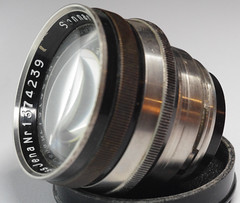Difference between revisions of "Sonnar 50mm"
m (→Soviet Copies: spelling) |
(→Design history) |
||
| Line 29: | Line 29: | ||
During the war, several variations were produced with cosmetic changes due to shortages of certain materials. In 1941 a version was produced with an aluminum aperture ring, and a nickel plated barrel. In 1942 other variations were produced, the first with a black filter ring. And a second in which the entire barrel was made from aluminum. And in 1943 a chrome lens was built without the finger grips on the aperture ring, and of a design that would reappear after the war. <ref name="Pacific1">[https://www.pacificrimcamera.com/pp/zicontax50f15.htm] Pacific Rim Camera photographica page on the Sonnar 5cm f/1.5</ref> | During the war, several variations were produced with cosmetic changes due to shortages of certain materials. In 1941 a version was produced with an aluminum aperture ring, and a nickel plated barrel. In 1942 other variations were produced, the first with a black filter ring. And a second in which the entire barrel was made from aluminum. And in 1943 a chrome lens was built without the finger grips on the aperture ring, and of a design that would reappear after the war. <ref name="Pacific1">[https://www.pacificrimcamera.com/pp/zicontax50f15.htm] Pacific Rim Camera photographica page on the Sonnar 5cm f/1.5</ref> | ||
| + | <!---[url=https://flic.kr/p/oqAwPB][img]https://live.staticflickr.com/5557/14718182289_ea6c9aba25_w.jpg[/img][/url][url=https://flic.kr/p/oqAwPB]Carl Zeiss Sonnar 1:1,5 f=5cm (1943)[/url] by [url=https://www.flickr.com/photos/siimvahur/]Siim Vahur[/url], on Flickr > | ||
After the war Zeiss was split between East and West Germany. The west Germany branch relaunched the lens as Zeiss-Opton Sonnar around 1950. These lenses had a new optical design, and were coated (red T). The body was chrome over brass. | After the war Zeiss was split between East and West Germany. The west Germany branch relaunched the lens as Zeiss-Opton Sonnar around 1950. These lenses had a new optical design, and were coated (red T). The body was chrome over brass. | ||
Revision as of 15:10, 11 December 2021
Sonnar is a lens made by Carl Zeiss Jena from 1932, at the time it was the fastest lens with a maximum aperture of f/1.5.

|
| Sonnar 50/1.5 Type1 (1932) aperture only 1.5 to 8 image by Pablo Coronel (Image rights) |
Contents
Design history
It is a Ludwig Bertele design with 7 elements in 3 groups. In order to avoid diffraction the elements were cemented together so as to minimize the air-to-glass interfaces.
The lens was first introduced in 1932 in black and nickel finish with a run of 155 [1]. The aperture ring is in the center of the lens. The lens has a diameter of 40.5mm internal and uses 42mm push-on filters. To avoid contrast problems due to diffraction, the aperture was limited to f/8. Iris has 16 blades.
The second version (1933) was slightly different optically and cosmetically, while still black and chrome it can be identified by the minimum aperture being changed to f/11. Bertele introduced slight changes in the formula and reduced the risk of diffraction. [1]
The third version (1935) also saw optical and cosmetic changes. The minimum aperture was changed again to f/16 after optical optimization. The barrel was changed to black, nickel and chrome and the front was threaded to accept 40.5mm filters, the aperture ring was moved to the front of the lens, and two little finger grips (ears). The iris has 13 blades from this model onwards.
Later that year the fourth version appeared. It was identical to the third version, except it was finished entirely in chrome. This is the most common prewar design. With this model, coating on the lenses began to be applied in the later models.
During the war, several variations were produced with cosmetic changes due to shortages of certain materials. In 1941 a version was produced with an aluminum aperture ring, and a nickel plated barrel. In 1942 other variations were produced, the first with a black filter ring. And a second in which the entire barrel was made from aluminum. And in 1943 a chrome lens was built without the finger grips on the aperture ring, and of a design that would reappear after the war. [2]